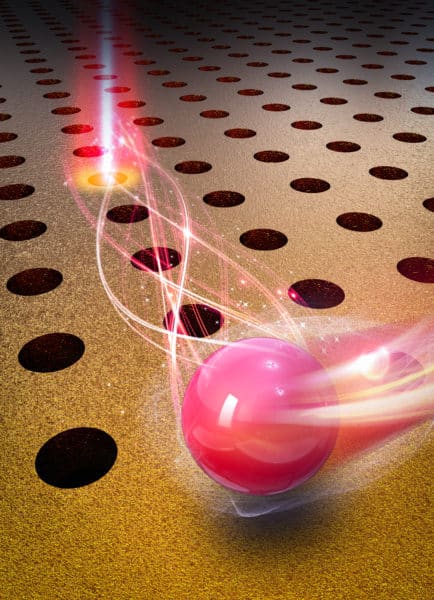Nanotweezers: A laser, an AC electric field and an array of gold ” make up the new device. justus>
A new type of optical tweezer can trap and manipulate objects smaller than 10 nm in size without damaging them. The hybrid opto-thermo-electrohydrodynamic device, which was developed by Justus Ndukaife and colleagues at Vanderbilt University in the US, could be used to control photosensitive biomolecules and other nanoscale objects.
Optical tweezers were invented by the American physicist Arthur Ashkin, who received a share of the 2018 Nobel Prize in physics for his work. These devices, which use a highly focused laser beam to generate forces that hold and move micron-sized objects in the beam’s trajectory, have emerged as powerful tools for biological research. They are, however, restricted in the size of the objects they can manipulate because of diffraction, which limits the spot size of the trapping laser beam to around half the wavelength of the illuminating light. For red light with a wavelength of 700 nm and a relatively low laser power of several mW, for example, tweezers can only stably trap and manipulate objects that have a diameter of roughly 350 nm or greater. To do the same to smaller objects, the laser power must be increased, which tends to destroy fragile biomolecules.
Moving away from the laser focus
The new opto-thermo-electrohydrodynamic tweezers (OTETs) avoid this problem by trapping nanometre-scale objects at locations several microns away from the high-intensity laser focus. Such objects are thus protected from the intense light and heat the laser produces.
The device is made up of an array of tiny holes 300 nm wide and 120 nm thick drilled in a very thin gold film. These structures, which are deposited on a glass substrate, are plasmonic, meaning that they interact strongly with light via surface plasmons (collective oscillations of electrons at the surface of a metal) at specific resonance frequencies. These interactions produce multiple electric field “hot spots” at which particles can be trapped.
The researchers created their tweezers by combining this array with a laser that has a wavelength of 973 nm and a focused beam diameter of 1.33 μm. Particles become trapped far from the laser focus thanks to an applied AC field (of 83 KV/m at a frequency below 10 kHz), which sets up a trapping potential several microns from the edge of the array along which the particles travel.
Trapping small molecules like DNA
Ndukaife thinks that OTETs could be used to trap small molecules such as DNA, and might also be used to sort objects based on their size. The latter task is important for researchers seeking to isolate specific biomolecules such as exosomes, which are extracellular vesicles that range from 30 to 150 nm in size and are known to play a role in cancer metastasis.
Other promising possibilities include detecting pathogens by trapping and analysing viruses, and studying proteins associated with neurogenerative diseases like Alzheimer’s. The technique could even aid the early detection of diseases since the tweezers are good at capturing molecules that are only present at low levels. The OTETs might also be combined with other imaging techniques such as biofluorescence and infrared spectroscopy.

Optical tweezer helps make phonon laser
“The sky is the limit when it comes to the applications of OTETs,” says Ndukaife, who collaborated with Vanderbilt’s Center for Technology Transfer and Commercialization to file a patent on the technology. “I am looking forward to seeing how other researchers harness its capabilities in their work.”
The research is detailed in Nature Nanotechnology.
